
The Northern Territory is an Australian internal territory in the central and central-northern regions of Australia. The Northern Territory shares its borders with Western Australia to the west, South Australia to the south, and Queensland to the east. To the north, the Northern Territory looks out to the Timor Sea, the Arafura Sea and the Gulf of Carpentaria, including Western New Guinea and various other islands of the Indonesian archipelago.

The population of Australia is estimated to be 27,537,700 as of 30 November 2024. It is the 54th most populous country in the world and the most populous Oceanian country. Its population is concentrated mainly in urban areas, particularly on the Eastern, South Eastern and Southern seaboards, and is expected to exceed 30 million by 2029.
Anglo-Celtic Australians is an ancestral grouping of Australians whose ancestors originate wholly or partially in the British Isles - predominantly in England, Ireland, Scotland and Wales, as well as the Isle of Man and Channel Islands.

The City of Mount Isa is a local government area in north west Queensland. The City covers the urban locality of Mount Isa, the administrative centre, and surrounding area, sharing a boundary with the Northern Territory to the west.

Asian Australians are Australians of Asian ancestry, including naturalised Australians who are immigrants from various regions in Asia and descendants of such immigrants. At the 2021 census, the proportion of the population identifying as Asian amounted to approximately 17.4 percent with breakdowns of 6.5 percent from Southern and Central Asia, 6.4 percent from North-East Asia, and 4.5 percent from South-East Asia.

Religion in Australia is diverse. In the 2021 national census, 43.9% of Australians identified with Christianity and 38.9% declared "no religion".

The Census in Australia, officially the Census of Population and Housing, is the national census in Australia that occurs every five years. The census collects key demographic, social and economic data from all people in Australia on census night, including overseas visitors and residents of Australian external territories, only excluding foreign diplomats. The census is the largest and most significant statistical event in Australia and is run by the Australian Bureau of Statistics (ABS). Every person must complete the census, although some personal questions are not compulsory. The penalty for failing to complete the census after being directed to by the Australian Statistician is one federal penalty unit, or A$220. The Australian Bureau of Statistics Act 1975 and Census and Statistics Act 1905 authorise the ABS to collect, store, and share anonymised data.

The Australian Bureau of Statistics (ABS) is an Australian Government agency that collects and analyses statistics on economic, population, environmental, and social issues to advise the Australian Government.
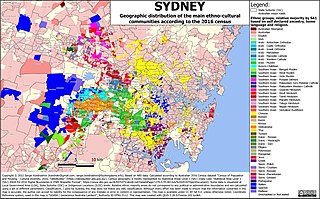
Sydney is Australia's most populous city, and is also the most populous city in Oceania. In the 2021 census, 5,231,147 persons declared themselves as residents of the Sydney Statistical Division–about one-fifth (20.58%) of Australia's total population. With a population density of 2037 people per square kilometre, the urban core has population density five times that of the greater region.

Serbian Australians, are Australians of ethnic Serb ancestry. In the 2021 census there were 94,997 people in Australia who identified as having Serb ancestry, making it a significant group with the global Serb diaspora.
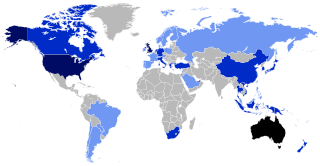
Australians, colloquially known as Aussies, are the citizens, nationals and individuals associated with the country of Australia. This connection may be residential, legal, historical or ethno-cultural. For most Australians, these connections exist and are collectively the source of their being Australian. Australian law does not provide for a racial or ethnic component of nationality, instead relying on citizenship as a legal status, though the Constitutional framers considered the Commonwealth to be "a home for Australians and the British race alone", as well as a "Christian Commonwealth". Since the postwar period, Australia has pursued an official policy of multiculturalism and has the world's eighth-largest immigrant population, with immigrants accounting for 30 percent of the population in 2019.
Paralowie is a suburb in the north of Adelaide, South Australia, 21.4 km (13.3 mi) north of the Adelaide city centre. It is predominantly a residential suburb.

English Australians, also known as Anglo-Australians, are Australians whose ancestry originates wholly or partly in England. In the 2021 census, 8,385,928 people, or 33% of the Australian population, stated that they had English ancestry. It is the largest self-identified ancestry in Australia. People of ethnic English origin have been the largest group to migrate to Australia since the establishment of the Colony of New South Wales in 1788.

Melbourne is Australia's second-most populous city and has a diverse and multicultural population.

European Australians are citizens or residents of Australia whose ancestry originates from the peoples of Europe. They form the largest panethnic group in the country. At the 2021 census, the number of ancestry responses categorised within European ancestral groups as a proportion of the total population amounted to more than 57.2%. It is impossible to quantify the precise proportion of the population with European ancestry. For instance, many census recipients nominated two European ancestries, tending towards an overcount. Conversely, 29.9% of census recipients nominated "Australian" ancestry, tending towards an undercount.
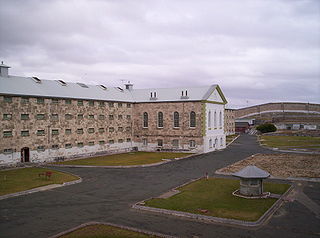
Punishment in Australia arises when an individual has been accused or convicted of breaking the law through the Australian criminal justice system. Australia uses prisons, as well as community corrections. When awaiting trial, prisoners may be kept in specialised remand centres or within other prisons.
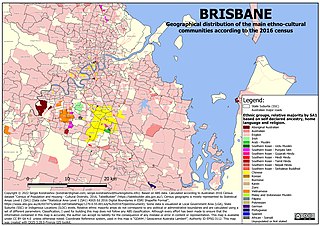
Brisbane is the capital of and most populous city in the Australian state of Queensland, and the third most populous city in Australia. The Australian Bureau of Statistics estimates that the population of Greater Brisbane is 2,462,637 as of June 2018, and the South East Queensland region, centred on Brisbane, encompasses a population of more than 3.6 million. The Brisbane central business district stands on the original European settlement and is situated inside a bend of the Brisbane River, about 15 kilometres from its mouth at Moreton Bay. The metropolitan area extends in all directions along the floodplain of the Brisbane River Valley between Moreton Bay and the Great Dividing Range, sprawling across several of Australia's most populous local government areas (LGAs), most centrally the City of Brisbane, which is by far the most populous LGA in the nation. The demonym of Brisbane is Brisbanite.
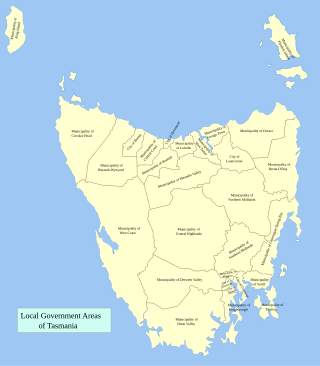
Former Local government areas (LGAs) in the Australian state of Tasmania are amalgamated or cancelled areas.
The 2016 Australian census was the 17th national population census held in Australia. The census was officially conducted with effect on Tuesday, 9 August 2016. The total population of the Commonwealth of Australia was counted as 23,401,892 – an increase of 8.8 per cent or 1,894,175 people over the 2011 census. Norfolk Island joined the census for the first time in 2016, adding 1,748 to the population.

















